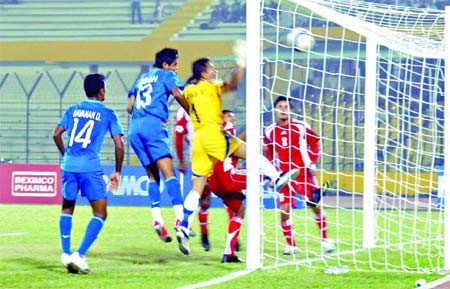“The style of football that was being played during Houghton’s era was flawed. The long ball game is absolutely unsuitable. The new coach should be able to bring with him possession football, the kind of passing game that is pleasing”
Quick question, spot what is wrong with the above statement? If you can’t figure out the evident fundamental flaw with this statement, well, then it’s time to ponder over the following explanation.
This statement was given by AIFF head honcho Mr Kushal Das when he was speaking about Bob Houghton’s potential replacement. There is absolutely nothing wrong with the first part of his statement. The tactics in Houghton’s era was indeed flawed, as we have criticised multiple times. Indian players were always ill suited to his long ball approach and it is good that we are finally thinking about doing away with it. However the AIFF official also expects Indian team to play possession based football which is pleasing to the eye; is it a realistic viewpoint at this point of time? Mr Das, seriously? Do you think you are dealing with Xavi, Iniesta and Lionel Messi here?
Herein lies one of the basic flaws of Indian football – we still don’t know how to use our resources. Our officials and managers have a pre-conceived notion of how football should be played and they are always hell bent on applying this idea to the team, irrespective of the players adapting to the tactics. How can we expect players who have played under Houghton’s long ball tactics in last five years to suddenly switch over and play a possession based football? They are not pre-programmed robots who will readily acclimatize to a totally different tactics. This is like expecting Justin Bieber to sing like Robert Plant or expecting Sidney Sheldon to write like Salman Rushdie. Will the English national team wake up one fine morning and suddenly start playing like Brazil? Never.
The guy on left side can never sing like the guy on right side
Based on Spain and FC Barcelona’s recent run of success it is easy to insist upon playing the brand of football that is pleasing to the eye but one must not forget the long planning and hard work that goes behind these teams. The reason why Barca play the type of football they do is because players who train with the club are trained to play like this from their childhood. In Barcelona’s world famous Academy La Masia, young kids are taught to embrace the Barca way of playing from the time they start their career. Their skills are honed with passing years – it is not an overnight achievement.
In 2001, a tournament called Millennium Cup was held in India. Several countries participated in it including the likes of China, Bosnia and Yugoslavia (current Serbia National team). In one of the interviews taken at that time the Yugoslav coach explained why his nation had consistently performed in European football despite political instability. Yugoslavia, once European champions and World Cup semi-finalists, had reached quarter final in Euro 2000. Dragan Pivic, the coach who had travelled with Yugoslav team said that every single youth level coach in Yugoslavia play their teams by 3-5-2 system. The reason was simple, the Federation wanted players to be properly groomed to the same system played by National team. This had resulted in Yugoslavs playing delightful football through out their history (they were often called Europe’s Brazil).
What made Rahim saab such a brilliant tactician was the fact that he knew when and what changes he needed to make in his systems. Initially India used to play the 2-3-5 system under Rahim though the three-back system was mostly used in European football. In 1954 Rahim was advised by British coach Albert Flatley to try out the three-back system. The Indian coach openly argued with Faltley – he knew that his players were not suited to the change. Rahim was not opposed to the change but he waited till he got suitable players. He finally adopted the three back system for 1956 Olympics – with brilliant results. Similarly, when India was facing a crisis in centre-forward position in 1962 Asian Games Rahim saab didn’t use PK Banerjee or Chuni Goswami as centre-forwards. Both were extremely skilled players and capable of scoring goals but Rahim knew their best usage was in their natural positions. Instead, he gambled with centre-back Jarnail Singh, pushing him up. This again yielded immediate results as Jarnail scored goals in both semi-final and final.
India doesn’t need a coach who will suddenly start playing a dynamically different system. India needs a coach who will understand players’ strengths and weaknesses and decide his tactics based on that. In India we do not have coaches teaching footballers possession football in youth level. The Indian Arrows team is coached by Desmond Bulpin, while U23 team was under Sukhwinder Singh – both coaches place their faith on long ball game ala Bob Houghton. It will be very unfair to expect youngsters like Jeje or Raju Gaikwad to suddenly adapt to possession football after graduating from the school of long ball. This mismatch of tactics will once again lead to poor performance of the team and subsequent sacking of the next manager – something Indian football can ill afford right now. The AIFF must be realistic in their expectations – if they want the national team to play possession football then they should take up necessary measures to introduce that style in grass root level. The change of approach has to be bottom up not top down.
Follow the author in Twitter – @somnath_THT
Follow thehardtackle in Twitter – @thehardtackle
